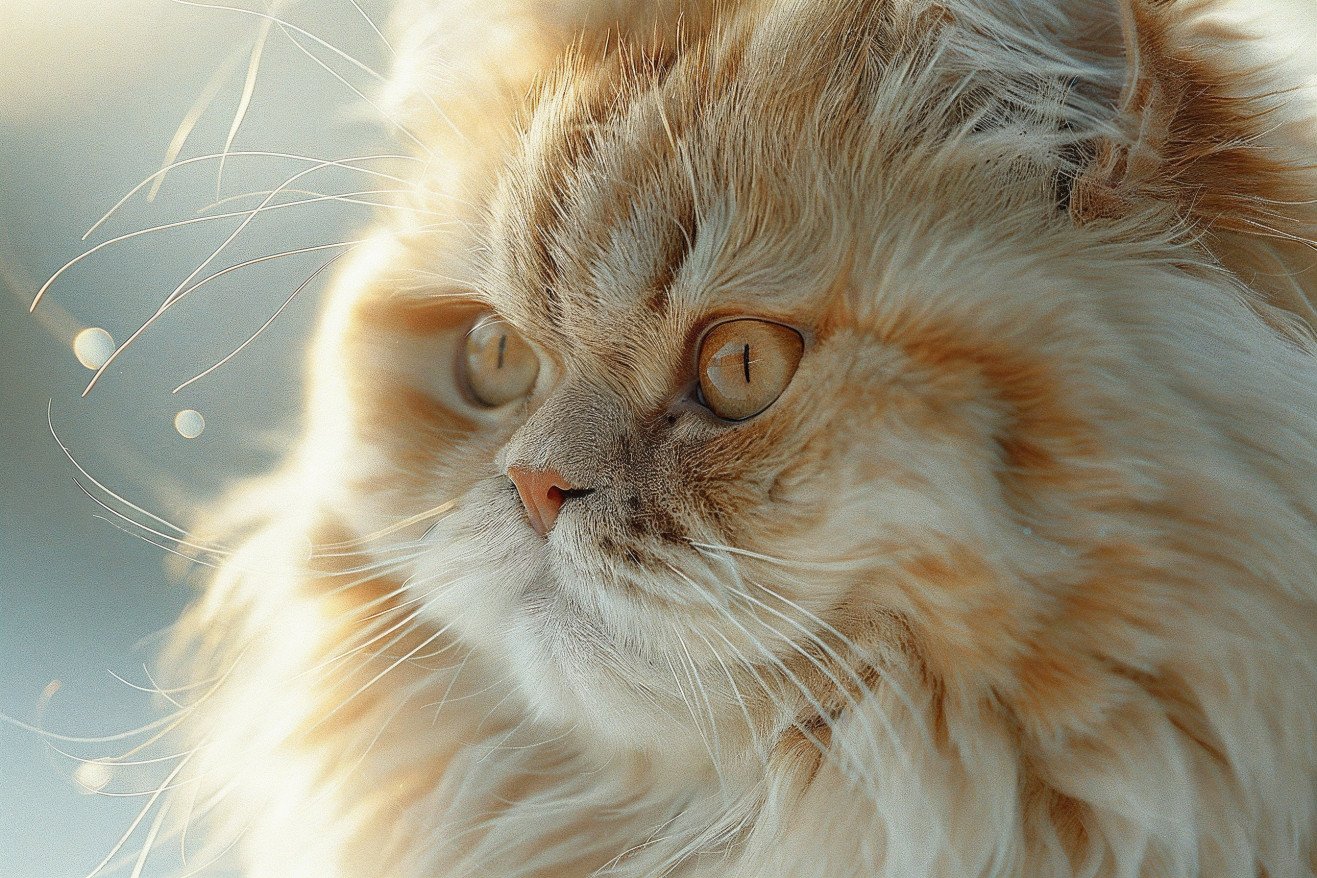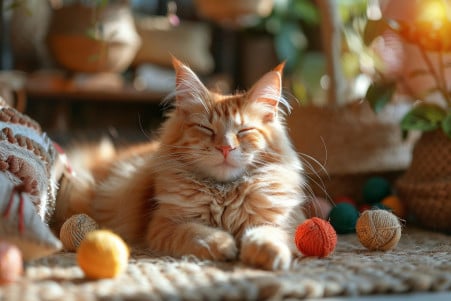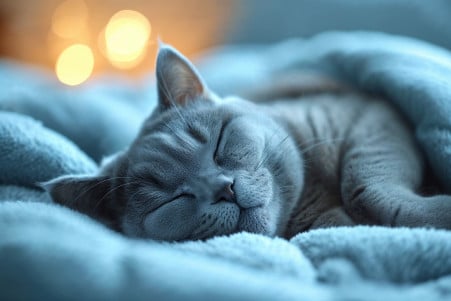Inside the Mind of a Cat: What Are Cats Thinking?
26 March 2024 • Updated 25 March 2024

Why does your cat give you a death stare, knead your legs for what feels like hours, or knock things off of your counters—what is going on inside the mind of a cat? While cats don't have the same kind of complex thoughts that people do, they do have rich emotional lives and instincts that shape the way they interact with the world. These instincts can often be mistaken for thoughts. So, what cats "think" is a combination of emotions, predatory instincts, communication, and sensory input.
To help you better understand what your cat is thinking, we'll take a deep dive into the latest research in veterinary and animal behavior science, which seeks to answer questions about the emotional lives of cats, the predatory behaviors of cats, how cats communicate, and how cats perceive the world around them. This will help you understand the science behind your cat's behavior and mental processes, which in turn will help you understand your cat better and strengthen your bond.
What do cats think about?
How Do Cats Communicate?
While cats can't talk in the traditional sense, they do have a complex system of communication that they use to express their feelings and needs. This system includes a combination of body language, vocalizations, facial expressions, and scent marking.
Body language is the most important part of this system, and everything from the position of a cat's tail to the direction of their ears can provide important information about how a cat is feeling. For example, a cat with a tail held high and straight up is feeling confident and friendly, while a cat with a tail tucked between their legs is feeling fearful or anxious. A cat with ears that are pricked forward is feeling alert, while a cat with ears that are flattened against their head (often called "airplane ears") is feeling threatened.
Vocalizations are another important part of a cat's communication system. While purring is often a sign of contentment, it can also be a sign of stress, and meows can be used to express everything from hunger to a desire to communicate, according to PetMD. Growls, hisses, and yowls are used to communicate discomfort and aggression and are often used in combination to communicate increasing levels of these feelings.
Scent marking is another important part of a cat's communication system, and cats use urine, feces, and secretions from glands to mark their territory and social status, according to the International Cat Care. Cats also use scratching to mark their territory, and the scent from the glands in their paws is left behind when they scratch objects.
By paying attention to these non-verbal cues, you can learn to understand what your cat might be "saying" and what they might be feeling. Understanding your cat's body language and other forms of communication can help you build a stronger bond with your pet.
How Do Cats Experience Time: Can Cats Tell Time?
Although cats don't have a human-like, clock-based concept of time, they do experience time in a number of ways. According to Cats.com, cats' activity levels are highest at dawn and dusk, so they use the sun's position in the sky as a way to tell time. They also rely on their own bodily needs, such as hunger and tiredness, to determine how much time has passed.
Cats are also very aware of the schedules and routines of their human families, according to Catster. This means they can learn to predict when certain things will happen, such as when they'll be fed or when their people will come home. This shows that cats have some sense of time, even if it's not as linear as the way humans perceive it.
Studies have shown that cats have biological rhythms, including circadian rhythms, that affect their sleep-wake cycles and other behaviors. Although cats don't have a specific way to tell time, these biological rhythms help them understand the passage of time. This is one reason why cats are often more comfortable when they have a regular routine.
Learning about how cats experience time can help us understand more about their minds and how they think. As we learn more about the depths of the feline mind, we'll likely discover more about how cats perceive the world.
The Depths of Feline Consciousness: Self-Awareness and Emotion Recognition
The depths of feline consciousness have been the subject of much research. One question that has been asked is whether cats have self-awareness and the ability to recognize themselves, a cognitive trait that has been associated with higher consciousness. While self-recognition in mirror tests has been demonstrated in several species, including some primates and dolphins, cats have shown a variety of responses to seeing themselves in a mirror.
One study found that cats often treated their reflection as another cat, either investigating it or acting defensively. This led the researchers to conclude that cats don't have the kind of self-awareness that has been demonstrated in other species. However, other studies have shown that cats may have more advanced cognitive abilities.
For example, a recent study demonstrated that cats can recognize and match emotional expressions in both human and feline faces and vocalizations. This suggests cats have social cognitive abilities and an understanding of the emotional states of their social partners. In addition, there is evidence that cats can mimic human behavior, which would require them to be able to understand and map their bodies to those of others.
These studies provide tantalizing evidence of the depths of feline consciousness and self-awareness. As we learn more about the feline mind, we may come to understand that cats' inner lives are even richer than we ever imagined.
Understanding Feline Memory: How Cats Form and Recall Memories
Cats have short-term and long-term memory that helps them learn and adapt to their environment. As noted by Petsmont, cats have particularly good short-term "working" memory, which helps them remember where things like food and hiding places are located. They also have long-term memory, which can last for years and even a cat's lifetime, especially when it comes to particularly good or bad memories.
A cat's memory can be affected by a number of things, including age, environment, and experiences. Modkat notes that as cats age, they may experience cognitive decline and memory loss, while good memories from kittenhood can last a lifetime. In addition, cats have excellent spatial memory, which they use to remember where things are in their environment and even where they can find food, as reported by Fear Free Happy Homes.
Positive experiences, including love, play, and treats, can help cats form positive memories and associations and improve their overall well-being, according to Catster. In addition, mental stimulation, including puzzle toys and environmental enrichment, can help cats maintain their cognitive function. As we learn more about how cats think, learning, and remember, we'll be able to better understand and care for these amazing animals.
Conclusion: Respecting the Feline Mind
Although we may never fully understand the feline mind, research has shed light on the cognitive abilities of cats. In addition to their rich emotional lives and communication skills, cats have impressive memory and learning abilities. They also experience the world in ways that are shaped by their senses and their instincts for survival.
Recognizing cats as intelligent, conscious beings can help us better understand their behavior and form stronger bonds with them. Future research and observation will continue to reveal more about the feline mind.


